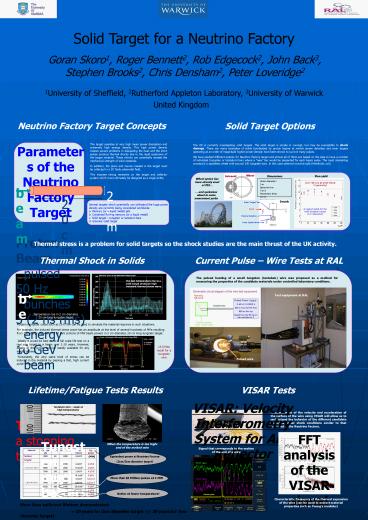Solid Target for a Neutrino Factory - PowerPoint PPT Presentation
1 / 1
Title:
Solid Target for a Neutrino Factory
Description:
mean power dissipation 0.75 MW. energy density ~ 300 J/cm3. The target operates at very high mean power dissipation and extremely high energy density. ... – PowerPoint PPT presentation
Number of Views:49
Avg rating:3.0/5.0
Title: Solid Target for a Neutrino Factory
1
Solid Target for a Neutrino Factory
Goran Skoro1, Roger Bennett2, Rob Edgecock2, John
Back3, Stephen Brooks2, Chris Densham2, Peter
Loveridge2
1University of Sheffield, 2Rutherford Appleton
Laboratory, 3University of Warwick
United Kingdom
Neutrino Factory Target Concepts
Solid Target Options
The target operates at very high mean power
dissipation and extremely high energy density.
This high power density creates severe problems
in dissipating the heat and the short pulses
produce thermal shocks due to the rapid expansion
of the target material. These shocks can
potentially exceed the mechanical strength of
solid materials. In addition, the pions and
muons created in the target must be collected in
a 20 Tesla solenoidal field. This imposes strong
restraints on the target and collector system
which must ultimately be designed as a single
entity.
The UK is currently investigating solid targets.
The solid target is simple in concept, but may be
susceptible to shock damage. There are many
examples of solids bombarded by proton beams at
similar power densities and even targets
operating at an order of magnitude higher power
density have been shown to survive many pulses.
We have studied different options for Neutrino
Factory target and almost all of them are based
on the idea to have a number of individual
(tungsten or tantalum) bars where a new bar
would be presented for each beam pulse. The most
interesting concept is a spokeless wheel with
around 150 tungsten bars. In this case solenoid
must be split (Helmholtz coil).
Parameters of the Neutrino Factory
Target Proton Beam pulsed 50 Hz
bunches 3 (2 ns rms) energy 10 GeV beam
power 4 MW Target (not a stopping target)
mean power dissipation 0.75 MW energy
density 300 J/cm3
Wheel
Solenoid
Dimensions
Pion yield
Wheel option has been already used at PSI
Outer diameter 5 m Speed at rim 5
m/s Revolution time 3.14 s Target spacing 100
mm of targets 157
Line Mercury jet yield (Study II geometry)
beam
2 cm
and spokeless wheel in some amusement parks
20 cm
Several targets which potentially can withstand
the huge power density are currently being
considered worldwide a. Mercury (or a liquid
metal) jets b. Contained flowing mercury (or a
liquid metal) c. Solid target tungsten or
tantalum bars d. Granular solid target
Accepted yields for the solid tungsten target
(1cm diameter)
Thermal stress is a problem for solid targets so
the shock studies are the main thrust of the UK
activity.
Thermal Shock in Solids
Current Pulse Wire Tests at RAL
Temperature rise ?C
The pulsed heating of a small tungsten (tantalum)
wire was proposed as a method for measuring the
properties of the candidate materials under
controlled laboratory conditions.
The fast temperature rise in a solid target
produces high transient thermal stress wave.
beam
Test equipment at RAL
Temperature rise in 2 cm diameter, 20 cm long
tungsten target
Modern computer codes such as LS-DYNA can be used
to simulate the material response in such
situations. For example, the induced thermal
stress wave has an amplitude at the level of
several hundreds of MPa resulting from the energy
deposition of 10 GeV protons (4 MW beam power) in
2 cm diameter, 20 cm long tungsten target.
Ideally it would be best to do a full scale life
test on a real size target in a beam over 1-10
years. However, beams of this power are not
readily available for any length of time.
Fortunately, the very same level of stress can be
induced in the material by passing a fast, high
current pulse through a thin wire.
LS-DYNA result for a tungsten wire
Pulsed wire
Lifetime/Fatigue Tests Results
VISAR Tests
VISAR Velocity Interferometry System for Any
Reflector
Tantalum wire weak at high temperatures
Measurements of the velocity and acceleration of
the surface of the wire using VISAR will allow us
to understand the behavior of the different
candidate materials under shock conditions
similar to that expected at the Neutrino Factory.
Tungsten much better!
When the temperature is too high end of the
melted wire
Signal that corresponds to the motion of the end
of a wire
Equivalent power at Neutrino Factory (2cm/3cm
diameter target)
(MW)
More that 26 Million pulses at 4 MW
Better at lower temperature!
Characteristic frequency of the thermal expansion
of the wire (can be used to extract material
properties such as Youngs modulus)
More than sufficient lifetime demonstrated gt 10
years for 2cm diameter target (gt 20 years for
3cm diameter target)































